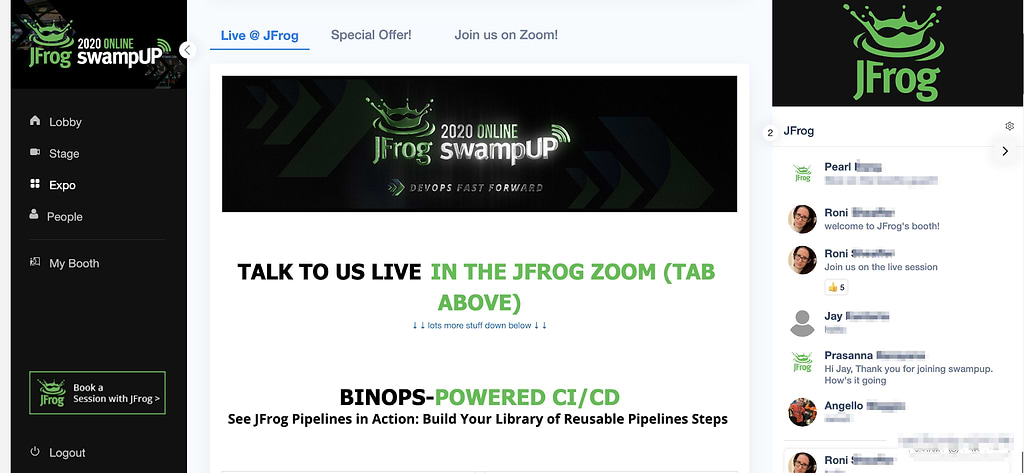Live or Die by 2022: DevOps in the Digital-First Economy
For companies to survive until 2022, they’ll need to focus on two things: Binaries and Edges. We’ve just wrapped up swampUP 2020, where we showcased this bold idea.
We heard from you firsthand how DevOps Fast Forward is a must, and how software must be able to be distributed anywhere to enable the continuity of any business. Your experience confirmed how the global crisis has accelerated the digital transformation in your companies.
We’ve already demonstrated that if you can’t scale your DevOps tools and methodologies, you’re wasting time with inferior technology. If your technology isn’t universal and flexible, you’re stuck with inefficiencies that will choke your innovation. If you’re not hybrid in your deployments with supporting tools, you’re missing the boat. You should demand these from any company promising DevOps solutions.

In a COVID-based reality, fast-forwarding DevOps is not just about advancing tools. If your company isn’t pushing forward and adopting new approaches immediately, your company will be dying by 2022.
See how Salesforce achieves massive DevOps scale, security and flexibility.
The Route To Survival
As companies scramble in the chaotic market to develop ever-more software, the focus has been on how to develop faster. How to secure faster. How to automate more, and ultimately how to get software production-ready. This is no longer enough.
The explosion of software not only necessitates building it better, smarter, faster, but also employing delivery mechanisms that control the movement of packages from your development environments all the way to the end user.
While some companies are moving their DevOps fulcrum closer to the source code by adopting GitOps, JFrog is taking a different path: a binaries-first mindset that we call BinOps.
The Edges
As seen in JFrog’s swampUP keynotes, the industry expects more than 7 million new edges by 2022, with over 30 BILLION new devices being served by those edges (credit: IDC). The journey of your software is not complete until it can get to the edge securely and rapidly as part of your development cycle.
Indulge an analogy for a moment: imagine we are building automobiles instead of software. For the past many years, we have focused on the nuts and bolts of the vehicle, as well as the assembly line to build it more quickly with safety and quality in mind. That’s a good thing. But this framework is very inward and process-focused.

Now imagine you are told you will need to sell 10x, 20x, 100x more vehicles in a short period of time. While your assembly line may be able to handle this production, your ability to get the vehicles from the manufacturer to the dealership (edge) where they can be safely distributed and consumed is not as sophisticated. The backlog begins, and your 7 million dealerships serving 30 billion new customers are slowly suffocated.
This will be your reality in 2022, where the edges are hungry for software packages, and your ability to get your digital packages to them is woefully insufficient, leaving room for your competition.
Capital One discusses building a definitive software library to deliver software to the edge.
The Binaries
But what do you eventually deploy at these edges? Software packages, of course. Since this is what you release to customers and into production, it only makes sense that these immutable binaries are what you track and manage throughout the process. It’s a philosophy we refer to as BinOps – managing the binary lifecycle in a constant manner.
In our automotive analogy, you ultimately need to get vehicles to 30 billion new customers. How do you track that? With VIN numbers – or in our case, package data. JFrog’s industry-leading build info metadata (that spans across the JFrog Platform, powered by JFrog Artifactory) allows you to manage packages and their contents all the way to the edge with an effective software bill of materials. You should be tracking the complete vehicle itself, as well as the components of the vehicle through their unique identifiers and dependence on one another. For your binaries, this means tracking the various packages and their sources alongside the release of the application itself.
Says Who?

JFrog was the first company to incorporate and integrate security solutions as an integral part of a DevOps pipeline with JFrog Xray, scanning your binaries within Artifactory along with all the metadata and dependencies at your service. JFrog is proud to once again have listened to the community and identified the next big issue facing development shops: getting any software to any edge in any environment.
The Next Leap of DevOps
As noted at swampUP, we’re busy fast-forwarding our roadmap – and your delivery – with the robust JFrog Platform. With existing, improved and new capabilities, we’re helping companies prepare for the realities of 2022 with mechanisms to keep your assembly lines efficient, and your internal and external distribution intact. We’re proud to give the community what it asked for and fast-forwarding your continuous software releases.
We’re happy to see other vendors stepping into the world of package management and realizing its value, and we welcome them to better support the real need and focus on the right assets in the pipeline – the edges and binaries.
If you adopt a binaries-first mindset focused on getting software to the edge, you’ll stand a chance in the next 18 months. Without this focus, in a rapidly-evolving, digital-first economy, you risk everything.






